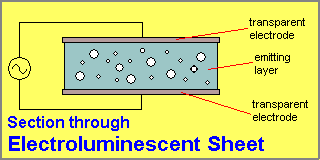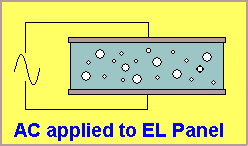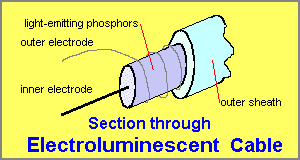ELECTROLUMINESCENCE
THEORY
HOW
EL WORKS
![]()
There is no recognised circuit symbol for electroluminescence material, however the symbol below is suitable and has been added to our
The way a piece of electroluminescent material gives off light is quite a complex phenomenon
and is beyond the scope of this article, but knowledge of the basics will help
you understand how a simple project works so you can design your own displays.
Electroluminescent
"wire" or "cable" is constructed with a thick, stiff, inner wire
surrounded by a coating of light-emitting phosphors and around this is wrapped
a very fine outer wire. An outer clear plastic jacket or sheath protects the
chemicals and insulates the voltages on the wire from external leakage. A
cut-away view is shown below:
Electroluminescent material comes in both sheet and wire
(cable) varieties. The
actual construction of these products is more complex that shown
above. The outer wire touches an extremely thin conducting film to produce the
outer electrode so an "electric field" will be produced
between the inner and outer wires.

The first thing to understand is how a circuit sees a piece of
electroluminescent material. It sees it as a capacitor. The resistance between
the two electrodes is almost infinite and thus DC will not pass through it.
But when an alternating voltage is applied, the build-up of a charge on the
two surfaces, effectively produces a increasing field (called an electric
field) and this causes the phosphors within the field to emit light. The
increase in voltage in one direction increases the field and this causes a
current to flow. The voltage then decreases and rises in the opposite
direction. This also causes a current to flow. The net result is a current
flows into (commonly thought of as "through") the electroluminescent
panel and thus energy is delivered to the panel. This energy is converted to
light via the panel and this conversion is a very efficient process since no
heat is produced in the process.
This makes EL a very efficient form of illumination.
The diagram below is a very simple representation of two electrodes and a thin
layer of electroluminescent material sandwiched between.
Note: each electrode is a layer of conducting material. It is so thin that
light is able to pass through and be emitted to the surroundings.


Watch the
sinewave
Note: light output
occurs during
both the positive and negative voltages.

For our discussion you can see two wires (electrodes) are present and these must be
connected to a voltage source of approx 100v AC. The term AC actually means
Alternating Current but it also refers to a voltage that is alternating. We
use the term AC to refer to an alternating voltage source. Electroluminescent material
will only give off light when an oscillating (alternating voltage) is supplied
to it. It does not work on DC (DC is the voltage supplied by a battery).
HISTORY
Electroluminescence was invented in 1936 by G. Destriau when
he discovered phosphors, such as copper- or manganese- doped zinc sulphide,
glow when subjected to a high voltage field (typically 10,000V/cm). Original
EL phosphors were deposited on glass plates. This made them very
rigid, thick and delicate. Panels are now thin, flexible, plastic
sheets, and can be created in almost any size and shape.
It is possible to purchase a large sheet and cut it into the desired shape.
This is only recommended for experimental work or for emergency repair
situations as two problems are encountered when doing this.
Firstly, the sheet must have terminating strips so you can connect to the
panel, secondly, cutting the sheet produces a raw edge that can
"flash-over" and produce sparks. Sometimes you can clean up the edge
with the sharp knife to increase the path between the electrodes and thus
reduce the occurrence of sparking. This sparking detracts considerably from
the energy delivered to the panel and if the sparking produces a
"track," all the energy will be lost in the
"short-circuit" and the panel will reduce in brightness or fade out
completely.
Once you know how to check the edge for sparking, cutting a sheet to a special
shape is the first stage of developing a project.
Remember, the final sheet will have a 0.5cm border of non-illumination, to
allow for the sealing between the two layers.
Sheets can also be made with more than one colour and although the layers
cannot be placed on top of one another, they can be laid in strips so that a
number of effects can be produced.
If three different phosphors are placed side-by-side, the final illumination
is less than 33% as compared with a single colour. In addition, the cost of
terminating the strips of colour is quite high.
CHANGING
THE COLOUR PRODUCED BY EL
The colour produced by an EL panel can
be altered by changing the frequency of the voltage supplied to it and/or
the amplitude of the voltage.
The change is much greater with some colours. You need to experiment to see
the effect. Some panels
have almost no visible shift at all. It all depends on who manufactured the
panel, its size and the type of inverter.
![]()